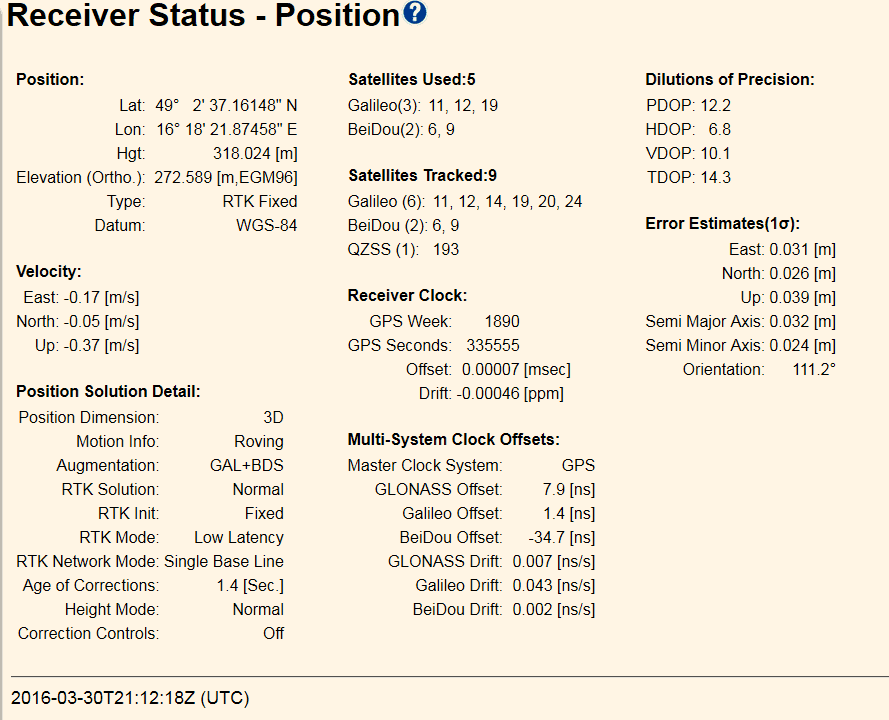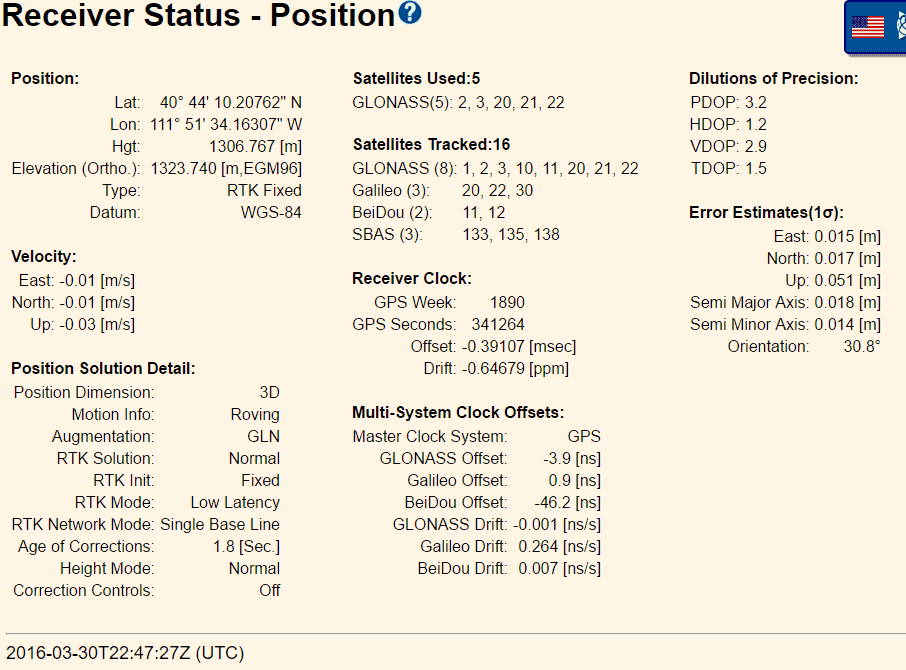Our R10 kits and a GS14 receive these satellites but we can't use them in a RTK solution because the base isn't enabled for them.
According to the Ashtech GNSS planning tool we could benefit from an extra 2-8 satellites depending on the time of day.
Are they "safe" to use? I presume the software has enough redundant observations to reject the data if it were to be bad?
There are not enough SV's over the U.S. to be able to use them in the solution. From what I have been told you need at least 5 in view of base and rover (1 to figure the timing of the signal and the other 4 or more for position). That is for each constellation.
That will change next year, and the system will be totally usable by 2017. Launching in pairs and late next year in quads will fill the constellation quickly.
I have seen an SP80 use them for a solution, since it does not need 4 or more of a particular set of satellites for a fix, but can use a mixture if you have at least 2.
squowse, post: 348439, member: 7109 wrote: Our R10 kits and a GS14 receive these satellites but we can't use them in a RTK solution because the base isn't enabled for them.
According to the Ashtech GNSS planning tool we could benefit from an extra 2-8 satellites depending on the time of day.
Are they "safe" to use? I presume the software has enough redundant observations to reject the data if it were to be bad?
I am using CHC X90s they use everything that is up there and I have been able to get a good fix in places were R8s & Hyper Units that my friends use won't ever come close to getting a fix. So i would think it might be worthwhile to try and acquire them.
Are their R8 and Hiper receivers enabled for those constellations?
I think I read that the next Galileo launches after Dec 17 would be quad launches.
squowse, post: 348720, member: 7109 wrote: Are their R8 and Hiper receivers enabled for those constellations?
No they are not. I don't think they can track the other satellites, they are set up for GPS & Glonass
New model R8's (R8 Model 4) will pick up those constellations. I demo'd one earlier this year.
Norman Oklahoma, post: 348752, member: 9981 wrote: New model R8's (R8 Model 4) will pick up those constellations. I demo'd one earlier this year.
I thought that the news one would.
R8 Models 3, 4, and S will track them.
Tracking them, and USING them in the solution are two separate items.
Yes, we all want more Satellite data. But it's important to find out if it is USING them in the solution, AND, what percentage of the solution is coming from them.
Not all things are true at face value. Just because it is advertised as USING them, technically they could be using them for 0.001% of the solution.... So, we just need to know more details.
Not all fixes are reliable.... (boy to we know this!) He he
N
If they have had the appropriate unlock code purchased and applied.
Nate The Surveyor, post: 349018, member: 291 wrote: Tracking them, and USING them in the solution are two separate items.
Yes, we all want more Satellite data. But it's important to find out if it is USING them in the solution, AND, what percentage of the solution is coming from them.
Not all things are true at face value. Just because it is advertised as USING them, technically they could be using them for 0.001% of the solution.... So, we just need to know more details.
Not all fixes are reliable.... (boy to we know this!) He he
N
Tell me about it i think that in some instances that any GPS will lie. What i was trying to say with the post about the other satellites was that if his rover would track and use them that I would think that it would be a good investment to upgrade his base to do the same as the access to those extra Satellites can make you more productive.
I'm going to do a test tomorrow. I'll use 1 R10 as a base and 1 as a rover. They are both GALILEO and BEIDOU enabled so I will see if they will use the 1-5 "bonus" satellites in each constellation in a RTK solution.
Using Trimble GNSS planning I get 1 to 6 GALLILEO and BEIDOU satellites available in the centre of USA today. For the UK it is 0 to 9 for the same time period.
Hoping to get 24 satellites at 2.30 pm tomorrow.
squowse, post: 349093, member: 7109 wrote: I'm going to do a test tomorrow. I'll use 1 R10 as a base and 1 as a rover. They are both GALILEO and BEIDOU enabled so I will see if they will use the 1-5 "bonus" satellites in each constellation in a RTK solution.
Using Trimble GNSS planning I get 1 to 6 GALLILEO and BEIDOU satellites available in the centre of USA today. For the UK it is 0 to 9 for the same time period.
Hoping to get 24 satellites at 2.30 pm tomorrow.
Did you ever run this test? If so what did you find?
If you have a base / rover with a newer Trimble GNSS board (BD970/BD930), that is fully enabled, with the latest 5.11 firmware installed you can now get a fix with BDU and GAL only. (Or any other combination or constellation that includes 5 SV's.
You can demo this by turning off tracking of all GPS and all GLONASS SV's on the rover.
Here is a screen shot of a receiver with a 5 SV fix (3 Gal and 2 BDU):
[INDENT=1]  [/INDENT]
[/INDENT]
(This particular fix was in Europe, but it works just fine here in Salt Lake City too.)
Here is an example of a GLONASS only fix in Salt Lake City:
[INDENT=1]  [/INDENT]
[/INDENT]
The Spectra Precision SP80 and SP60 will do the same thing.
There are times during the day when it really adds up.
So I believe that a reasonable take-away might be that if you are purchasing a new GNSS receiver, at a minimum it should track:
[INDENT=1]GPS L1-C/A, L2E, L2C, L5
SBAS L1-C/A, L5
GLONASS L1-C/A, L1P, L2-C/A, L3
Galileo E1, E5-A, E5-B, E5-AltBOC
BeiDou B1, B2
QZSS L1-C/A, L1-SAIF, L2C, L5[/INDENT]
And the receiver "Should Track" not just "have the ability to track." You need to be very, very careful here.
- There is a major brand of equipment that advertises that it tracks ALL FOUR constellations, but the fine print discloses that only three constellations can be tracked simultaneously AND to make it worse, switching constellations requires a major activation code nightmare. New GNSS equipment should track GPS + GLO + GAL + BDU simultaneously. If you are working in Asia Pacific, your receiver should also track QZSS.
- There are other brands that may track all four constellations, but only basic GPS and GLONASS are activated when you purchase the equipment. Turning on L2C, L5, Galileo, BeiDou costs extra and the cost may be significant.
- New equipment should NOT be GPS centric. In other words, you should be able to get FIXED solutions with any constellation or combination of constellations. There may be a week when the US GPS system is unavailable (for whatever reason.) It would be great to have a system that will work with GLO + GAL + BDU so that you can still be productive.
Currently these newer constellations (Gal and BDU) are best supported in matched Base / Rover pairs. You must use either the proprietary message types (CMRx, sCMRx, RTCM3.2 [MSM] ) too as earlier message types (CMR+, DBEN, RTCM2, RTCM3.1) may not carry all of the possible signals.
If you are working in wide open environments (like west of Salt Lake City) these extra signals won't make a bit of difference. But, if you are working in canyons, canopy or trying environments (like east of Salt Lake City in the forest) then more satellites is definitely more better.
Since most networks don't support GAL and BDU at this time, you won't see much benefit when using these modern receivers in network environments. (Some of the manufacturers claim that they can use SV's that are not in common with the base by auto-generating correctors at the rover for them; but I don't know how to show or test this.) But you certainly can use the network to set a base, then use the base with a matched rover for network derived coordinates under canopy with full tracking.
You don't need to spend more money to get this capability. Full constellation tracking is available today, at very reasonable prices, in very high quality devices.
M
Plumb Bill, post: 365986, member: 226 wrote: Did you ever run this test? If so what did you find?
Ha! I can't really remember, but we did get 2-3 extra satellites on average after we enabled the new constellations on the base.
Mark's post above covers a lot more than I found out about the new constellations. Thanks!
I'm user of Trimble R2 (fw 5.20) and base station built on bd970 (fw 5.11). It definitely is significant, to use BDU and GAL. Galileo will get complete support in 5.20 FW, but even with 5.11 I normally worked with more than 20 fixed SVs. It's not more precise, but you have much more robust solution. With bad conditions I'm still able to work. Many surveyors not... 🙂
Ugg old indian say, more sats, the better!



